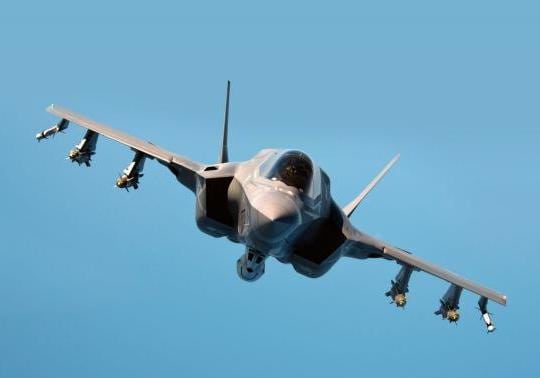[Avionics Today 04-22-2015] The Department of Defense (DOD) and industry partners still have structural and budgetary issues to address as the F-35 Joint Strike Fighter (JSF) program moves forward with plans to increase spending and production, according to a report released by the Government Accountability Office (GAO) early last week. With nearly two years and 40 percent of development testing still on the agenda for the $400 billion program, the GAO finds that the DOD and industry partners such as Lockheed Martin may be in dangerous territory.
 |
| F-35B test aircraft in flight. Photo: F-35 Lighting II |
The program encountered problems with engine durability on a test aircraft last year as a Pratt & Whitney F135 fan cracked during an accelerated mission test at only 77 percent of its required life. The blow up, alongside software challenges, caused members of the JSF program to make several unexpected changes and ultimately resulted in further delays to development and test plans. Meanwhile, DOD and Lockheed have put plans in place to ramp up production and annual aircraft procurement from 38 to 90 over the next five years while concurrently developing and testing the aircraft, which may be a risky activity. GAO believes that increasing production while simultaneously developing the aircraft jeopardizes the stability of the program and could essentially result in added costs and schedule delays.
“While DOD has taken steps over the past few years to reduce concurrency, the program’s strategy still contains a noteworthy overlap between the completion of flight testing and the increase in aircraft procurement rates. With the flight testing of the more complex software and advanced capabilities still ahead and reliability improvements needed, we believe that it is almost certain that the program will discover more technical problems,” Michael J. Sullivan, director of acquisition and sourcing management for the GAO stated in a testimony to the House of Representatives accompanying the report.
Depending on the nature and significance of the findings, GAO says it’s highly likely that it will take much more time and money to field current aircraft as well as incorporate design changes.
With much uncertainty regarding the program as it moves into the future, the main concerns going forward surround questions of affordability for the U.S. government both now and well into the future.
“According to current projections, the U.S. portion of the program will require acquisition funding of $12.4 billion a year, on average, from now through 2038 to complete development and procurement of 2,457 aircraft. DOD also estimates that the F-35 fleet will cost around $1 trillion to operate and support over its lifetime, which poses significant long-term affordability challenges for the department,” said Sullivan.
GAO believes it’s unlikely the program will be able to sustain the high level of annual funding it is anticipating. The report calls for the DOD to further analyze affordability in order to accurately inform long-term investment decisions, particularly as it will likely take more money and time than originally anticipated to establish engine reliability.
In yesterday’s first quarter 2015 conference call for Lockheed Martin, however, the company’s Chairman, President and Chief Executive Officer Marillyn Hewson pushed back against such reports that claim the F-35 program is off balance and off schedule.
“I think it’s key not to react to every media write-up that’s going to say it’s the largest program and will reflect back on the initial stages of the program,” said Hewson. “Since we re-baselined our program in 2010 we have been on track with our costs and our scheduled performance, we have rolled out a blueprint for affordability jointly with the U.S. government that is driving the costs down, and by the time we move into full-rate production, the cost of the F-35 will be comparable to or lower than a fourth generation fighter, with much more capability.”
As the report turns to concerns over the F-35 JSF program’s ability to maintain funding while competing with other large, high-priority programs such as new bomber, tanker, submarine and aircraft carrier priorities in the DOD budget, Hewson is steering the F-35 outlook in a positive direction.
“From a status standpoint, if you look back at some of the technical challenges we had early on, we’ve solved the landing hook, we’ve solved the helmet issues, the software programs are going well; so, from that perspective the programs are maturing. The development program that we’re moving through, we’re 65 percent complete on that and we’re going to continue to ramp up production,” said Hewson.
Hewson feels that the ramp up in production and the gains in manufacturing efficiency, which the report notes are heading in the right direction, are a good thing overall. She also sees key milestones ahead as the marine corps is ramping up this summer to meet their Initial Operating Capability (IOC) its F-35A variant.
“I would just encourage you to watch us track through the ramp up of the production, the things we’re doing to drive the costs down as we continue to move through the flight test services,” said Hewson. “And as each of these programs continue to declare initial operating capability, and as we continue to roll out more and more capability for the aircraft, I think that our nation and our allies are going to be very proud to have the security requirements capabilities that this aircraft will provide for many years to come.”